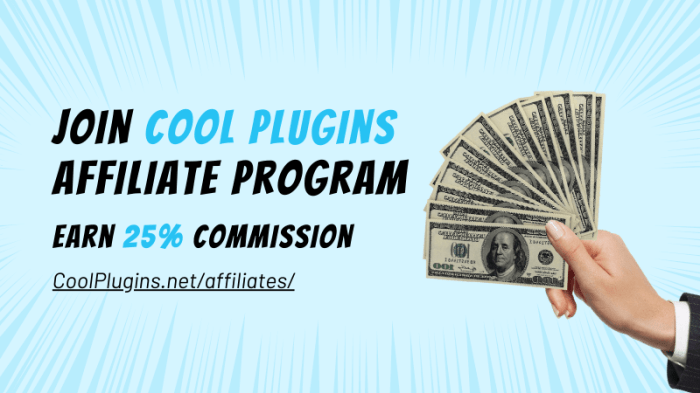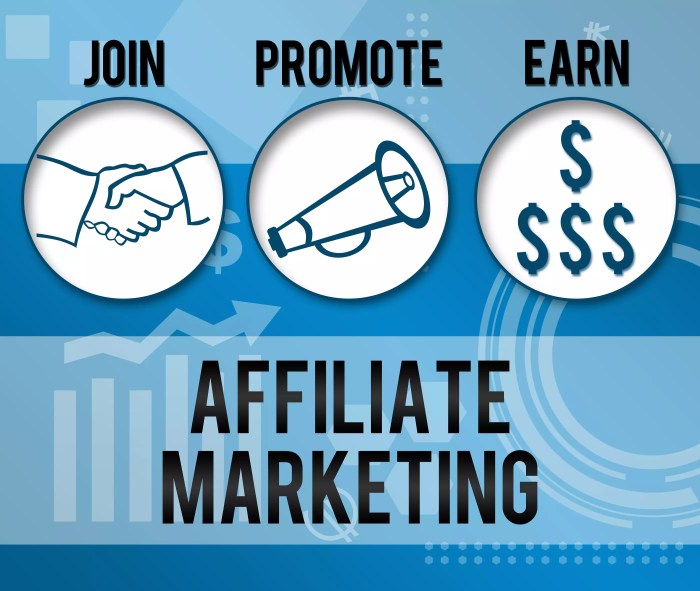Affiliate Program Ideas takes center stage in the digital marketing world, offering a glimpse into the realm of lucrative partnerships and creative marketing tactics that drive businesses forward. Get ready to dive into the dynamic world of affiliate programs and uncover the secrets to boosting your brand’s success.
In this guide, we’ll explore the ins and outs of affiliate programs, from different types to effective marketing strategies, providing you with the tools you need to thrive in the competitive online landscape.
Affiliate Program Ideas
Affiliate programs are a marketing strategy where businesses partner with individuals or other businesses (affiliates) to promote their products or services in exchange for a commission on sales generated through the affiliate’s unique link or code. This creates a win-win situation where the business gains more customers, and the affiliate earns money through referrals.
Types of Affiliate Programs
- Pay-Per-Sale: Affiliates earn a commission for every sale made through their referral link.
- Pay-Per-Lead: Affiliates earn a commission for each lead they generate, such as signing up for a newsletter or filling out a form.
- Pay-Per-Click: Affiliates earn a commission for each click on their affiliate link, regardless of whether a sale is made.
Benefits of Starting an Affiliate Program for Businesses
- Increased Sales: Affiliate programs can help businesses reach a wider audience and drive more sales through the efforts of affiliates.
- Cost-Effective Marketing: Businesses only pay affiliates when they generate a sale or lead, making it a cost-effective marketing strategy.
- Brand Awareness: Affiliates can help increase brand awareness by promoting products or services to their own followers and audience.
Niche Selection
Choosing the right niche for an affiliate program is crucial for the success of your marketing efforts. A niche refers to a specific segment of the market that you will focus on promoting products or services to. By selecting a niche that aligns with your interests, expertise, and target audience, you can increase the chances of driving traffic, generating leads, and earning commissions.
Popular Niches in Affiliate Marketing
- Health and Wellness: This niche includes products related to fitness, nutrition, weight loss, and overall well-being.
- Personal Finance: Helping people manage their money, invest wisely, and save for the future is a profitable niche.
- Technology and Gadgets: With the constant demand for the latest gadgets and tech products, this niche can be lucrative.
- Beauty and Skincare: Promoting makeup, skincare products, and beauty tools can attract a large audience.
Tips for Selecting a Profitable Niche
- Research Market Trends: Look for niches that are growing in popularity and have a consistent demand.
- Identify Your Passion: Choose a niche that aligns with your interests and expertise to create authentic content.
- Consider Profitability: Evaluate the earning potential of the niche by analyzing commission rates and competition levels.
- Understand Your Audience: Define your target audience’s needs, preferences, and pain points to tailor your marketing strategies.
- Test and Iterate: Experiment with different niches, products, and promotional tactics to find what resonates best with your audience.
Commission Structures

Commission structures play a crucial role in the success of affiliate programs. Let’s compare and contrast different commission structures commonly used, discussing the pros and cons of each, along with examples of successful affiliate programs with unique commission structures.
Pay-Per-Sale (PPS)
Pay-Per-Sale is one of the most common commission structures where affiliates earn a percentage of each sale they refer. This structure offers the potential for high earnings but may require a higher volume of sales to see significant profits. Successful programs like Amazon Associates use this model effectively.
Pay-Per-Lead (PPL)
Pay-Per-Lead involves affiliates earning a commission for each lead they generate for the merchant, typically through form submissions or sign-ups. While PPL offers a more accessible entry point for affiliates, the conversion rate of leads to actual sales may vary. Examples include Survey Junkie’s affiliate program.
Pay-Per-Click (PPC)
Pay-Per-Click pays affiliates based on the number of clicks generated on the affiliate link, regardless of whether a sale is made. This structure provides a steady stream of income for affiliates but may require high traffic to be profitable. Google AdSense is a well-known program utilizing PPC.
Tiered Commission Structure
Tiered commission structures offer different commission rates based on the performance of affiliates. Affiliates can earn more as they reach higher sales or lead thresholds, providing motivation for growth. Programs like Shopify Affiliate Program implement tiered structures effectively.
Recurring Commission
Recurring commission structures pay affiliates a commission for every recurring payment made by customers referred by the affiliate. While it may take longer to see significant earnings, it offers the potential for passive income over time. Successful examples include ClickFunnels Affiliate Program.
Marketing Strategies: Affiliate Program Ideas

In the world of affiliate programs, having effective marketing strategies is crucial for success. Whether it’s through content marketing, social media, or influencer partnerships, the way you promote your program can make all the difference in driving conversions and maximizing earnings. Here, we’ll explore some key strategies to help you optimize your marketing efforts for better results.
Content Marketing
Content marketing plays a significant role in promoting affiliate programs. By creating high-quality, relevant content that resonates with your target audience, you can attract more visitors to your site and increase the chances of them converting. Some tips for leveraging content marketing in your affiliate program include:
- Creating valuable and engaging content that provides real value to your audience.
- Optimizing your content for to improve visibility and attract organic traffic.
- Incorporating affiliate links naturally within your content to drive conversions without being too salesy.
- Utilizing different types of content such as blog posts, videos, and infographics to cater to diverse audience preferences.
Social Media, Affiliate Program Ideas
Social media platforms offer a powerful way to reach a wide audience and promote your affiliate program. Leveraging social media effectively can help you increase brand awareness, drive traffic, and generate leads. Some tips for optimizing your social media marketing efforts include:
- Identifying the right social media platforms where your target audience is most active.
- Engaging with your followers by sharing valuable content, running contests, and responding to comments and messages.
- Using social media ads to target specific audience segments and drive conversions.
- Collaborating with influencers or brand ambassadors to reach a larger audience and build credibility.
Influencer Partnerships
Partnering with influencers can be a game-changer for your affiliate program. Influencers have a loyal following and can help you reach a highly engaged audience that trusts their recommendations. When forming influencer partnerships, consider the following tips:
- Research and identify influencers whose values and audience align with your brand.
- Establish clear expectations and guidelines for the partnership to ensure a mutually beneficial relationship.
- Provide influencers with unique discount codes or affiliate links to track their performance and incentivize conversions.
- Monitor and analyze the results of your influencer partnerships to refine your strategies and optimize future collaborations.
